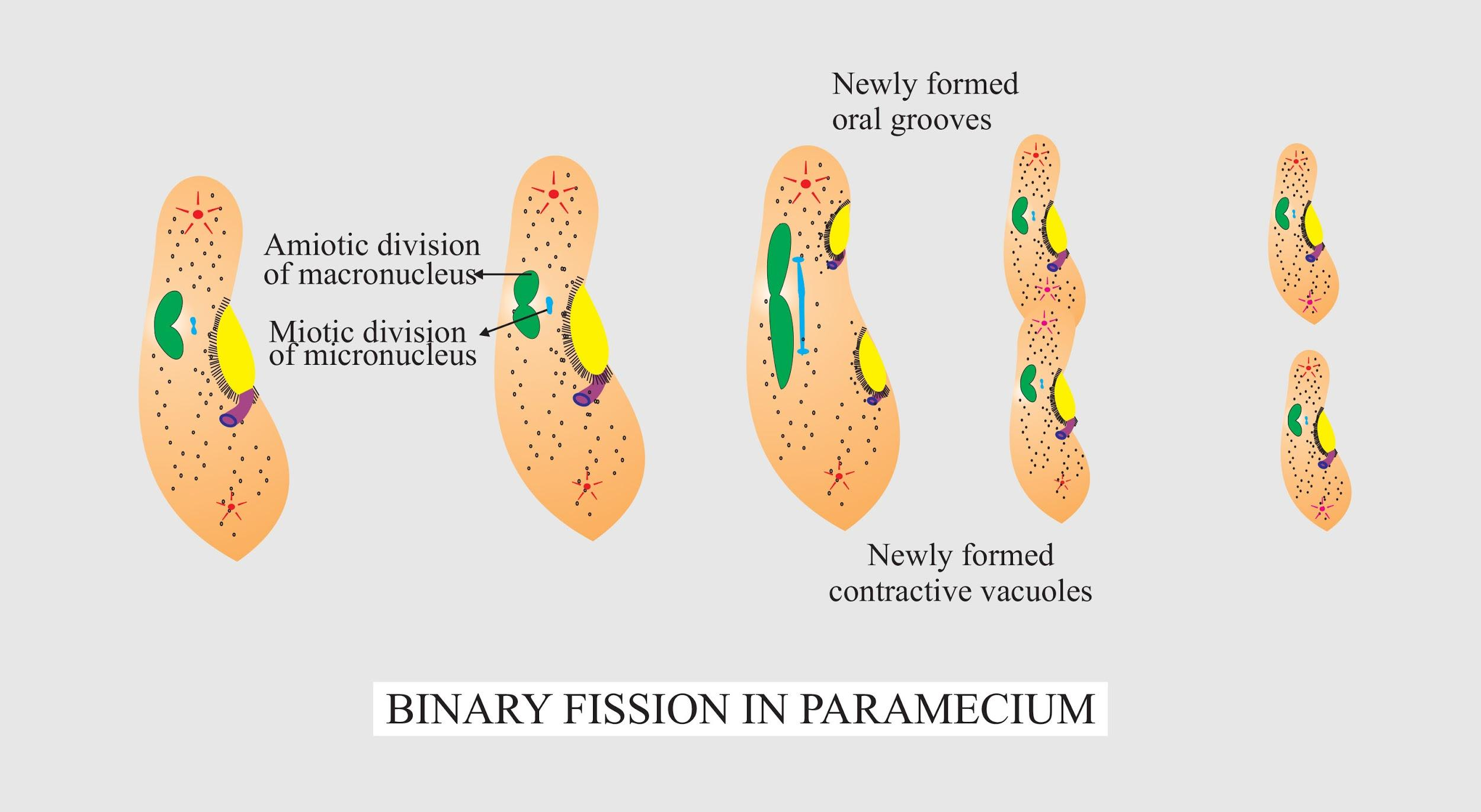
Paramecium reproduces by the process of
(A)Binary fission
(B)Multiple fission
(C)Fragmentation
(D)Regeneration
Answer
549.9k+ views
Hint: Paramecium has a special type of reproductive cycle due to its dual nuclear apparatus. They reproduce asexually and induce autogamy or conjugation in certain cases. Their germline nucleus undergoes mitosis during the reproduction phase.
Complete answer:
The asexual reproductive process seen in Paramecium is binary fission.
Paramecium contains a dual nuclear Apparatus like any other ciliates and it consists of polyploid macronucleus and one or more diploid micronuclei. The micronucleus is the germline nucleus and contains genetic material whereas the macronucleus controls non-reproductive cell functions. During binary fission in Paramecium, the macronucleus splits by amitosis whereas the micronuclei undergo mitosis. After that, the cell divides transversally and the new offsprings obtain a copy of both macro and micronucleus.
Additional Information:
We know, in binary fission the mother cell is divided into two identical daughter cells, but in the case of multiple fission instead of 2, many daughter cells are produced from the mother cell. This happens because the nucleus undergoes repeated divisions to produce a large number of nuclei and each of them along with a little bit of cytoplasm forms a membrane around it and becomes an independent cell.
In the case of Fragmentation, the organism splits into fragments and each of them develops into a mature organism identical to the parents. It is seen in many fungi like molds, lichens, animals such as sponges, acoel, flatworms, in bacteria like Cyanobacteria, etc.
Regeneration term has a broad aspect. It includes the process of renewal, restoration, and tissue growth that makes genomes, cells, organisms, etc resilient to natural fluctuation that causes damage. After Fragmentation of an organism, each part regenerates to create a complete organism.

So, the correct answer is “binary fission”.
Note: In Paramecium fission may occur spontaneously and in certain conditions, it may be preceded by autogamy or may follow conjugation. In conjugation, paramecium fuses temporarily and exchanges the genetic material. The micronuclei of each conjugant divide by meiosis and the haploid gamete pass from one cell to the other whereas the old macronuclei are destroyed and new ones develop from the new micronuclei.
Complete answer:
The asexual reproductive process seen in Paramecium is binary fission.
Paramecium contains a dual nuclear Apparatus like any other ciliates and it consists of polyploid macronucleus and one or more diploid micronuclei. The micronucleus is the germline nucleus and contains genetic material whereas the macronucleus controls non-reproductive cell functions. During binary fission in Paramecium, the macronucleus splits by amitosis whereas the micronuclei undergo mitosis. After that, the cell divides transversally and the new offsprings obtain a copy of both macro and micronucleus.
Additional Information:
We know, in binary fission the mother cell is divided into two identical daughter cells, but in the case of multiple fission instead of 2, many daughter cells are produced from the mother cell. This happens because the nucleus undergoes repeated divisions to produce a large number of nuclei and each of them along with a little bit of cytoplasm forms a membrane around it and becomes an independent cell.
In the case of Fragmentation, the organism splits into fragments and each of them develops into a mature organism identical to the parents. It is seen in many fungi like molds, lichens, animals such as sponges, acoel, flatworms, in bacteria like Cyanobacteria, etc.
Regeneration term has a broad aspect. It includes the process of renewal, restoration, and tissue growth that makes genomes, cells, organisms, etc resilient to natural fluctuation that causes damage. After Fragmentation of an organism, each part regenerates to create a complete organism.

So, the correct answer is “binary fission”.
Note: In Paramecium fission may occur spontaneously and in certain conditions, it may be preceded by autogamy or may follow conjugation. In conjugation, paramecium fuses temporarily and exchanges the genetic material. The micronuclei of each conjugant divide by meiosis and the haploid gamete pass from one cell to the other whereas the old macronuclei are destroyed and new ones develop from the new micronuclei.
Recently Updated Pages
Master Class 11 Social Science: Engaging Questions & Answers for Success

Master Class 11 Physics: Engaging Questions & Answers for Success

Master Class 11 Maths: Engaging Questions & Answers for Success

Master Class 11 Economics: Engaging Questions & Answers for Success

Master Class 11 Computer Science: Engaging Questions & Answers for Success

Master Class 11 Chemistry: Engaging Questions & Answers for Success

Trending doubts
What is meant by exothermic and endothermic reactions class 11 chemistry CBSE

10 examples of friction in our daily life

One Metric ton is equal to kg A 10000 B 1000 C 100 class 11 physics CBSE

1 Quintal is equal to a 110 kg b 10 kg c 100kg d 1000 class 11 physics CBSE

Difference Between Prokaryotic Cells and Eukaryotic Cells

The camels hump is made of which tissues a Skeletal class 11 biology CBSE




